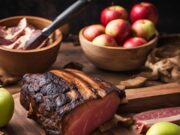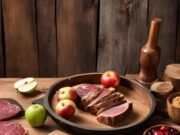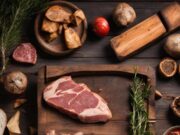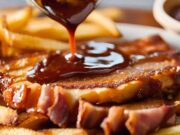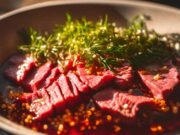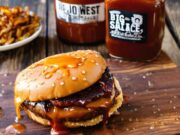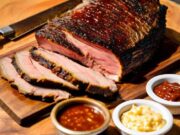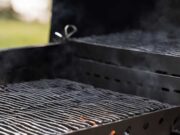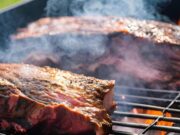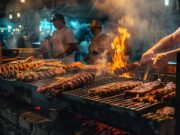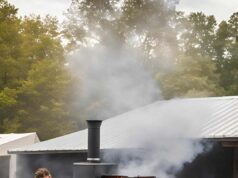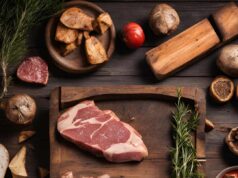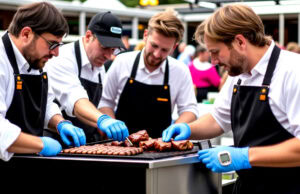Searing is more than just a cooking technique; it is a culinary art that transforms food through the science of the Maillard reaction. This fascinating process enhances flavor and texture while playing a crucial role in retaining juiciness.
In this exploration, you will discover the definition and history of searing, delve into the science behind the Maillard reaction, and learn effective techniques for achieving that perfect crust. Common myths surrounding searing will be debunked, providing you with valuable insights to elevate your cooking skills.
Prepare to uncover the secrets to mastering this essential culinary technique.
Key Takeaways:
- The Maillard reaction is a chemical process that creates delicious flavors, textures, and juiciness in seared food.
- Factors like temperature, time, and pH can impact the Maillard reaction and the resulting flavor of seared food.
- Mastering searing techniques, such as pan searing, grill searing, and sous-vide searing, is crucial for achieving the perfect sear and enhancing the overall taste of a dish.
Comprehensive Outline: The Science of Searing: Understanding the Maillard Reaction
The Maillard reaction is a fascinating and complex chemical process that occurs during cooking, transforming the flavors and aromas of various foods, including steak, through the interaction of proteins and sugars when exposed to heat.
Discovered by French chemist Louis-Camille Maillard in 1912, this reaction not only enhances the sensory qualities of cooked dishes but also contributes to the browning and delightful aroma associated with perfectly seared meats and baked goods.
Understanding this remarkable process is essential for you, whether you are a chef or a home cook, as you strive to create delicious and satisfying meals that tantalize the taste buds.
Definition and Historical Perspective
Searing is a cooking technique that utilizes high heat to caramelize the surface of food, particularly meat. This process enhances flavors and creates an appealing visual presentation through the Maillard reaction, a phenomenon discovered by French chemist Louis-Camille Maillard in the early 20th century.
This technique is essential in culinary practices because it not only enhances taste but also locks in moisture, resulting in a tender and juicy dish. Understanding the historical context of the Maillard reaction illustrates how this groundbreaking chemical process has significantly impacted cooking, adding depth and complexity to flavors that were once unattainable.

As chefs gained insight into the importance of this reaction, cooking techniques evolved, leading to various methods that leverage the principles of high heat and timing.
Today, searing is recognized for its ability to transform ordinary ingredients into exquisite dishes, effectively bridging traditional methods with contemporary gastronomy.
The Science Behind the Maillard Reaction
The science behind the Maillard reaction involves a complex interaction between proteins and reducing sugars when exposed to heat. This process results in a diverse array of flavors, aromas, and visually appealing browning in cooked foods, such as steak and baked goods.
Understanding this reaction can enhance culinary techniques and improve the overall quality of food preparation.
What is the Maillard Reaction?
The Maillard reaction is a complex chemical process that occurs when proteins and reducing sugars are exposed to heat. This process triggers a series of reactions that produce a diverse range of delicious flavors and appealing colors in cooked food.
This intricate interaction begins when heat catalyzes the reaction between amino acids from proteins and reducing sugars such as glucose or fructose. As the temperature rises, the reaction progresses through multiple stages, ultimately leading to the formation of various intermediate compounds. This culminates in a rich, complex array of flavors and brown pigments known as melanoidins.
For example, when you sear a steak, the Maillard reaction contributes to the savory crust that enhances the taste. In baked goods like cookies, it not only creates an enticing golden-brown color but also amplifies the sweetness and depth of flavor. These transformative effects underscore the significance of the Maillard reaction in the culinary arts.
Factors Influencing the Maillard Reaction
Several factors influence the Maillard reaction, including heat, moisture, time, and the specific ingredients used. Each of these elements plays a crucial role in determining the intensity of browning, the development of flavors, and the overall quality of the cooked dish.
For instance, the intensity of heat is paramount; higher temperatures typically accelerate the reaction, resulting in the desirable golden-brown crust found on seared meats or roasted vegetables. Conversely, if the heat is too low, the food may cook evenly without achieving the rich flavor associated with browning.
Moisture levels also significantly contribute to the process; excess water can create steam, which hinders the Maillard reaction, while drier conditions facilitate optimal caramelization. Additionally, various cooking techniques influence the process; for example, baking a loaf of bread at the correct temperature creates a crust that enhances flavor.
The composition of ingredients, such as sugars and amino acids present in protein-rich foods, can either promote or limit the reaction. This illustrates how nuanced cooking techniques can transform a simple dish into a culinary masterpiece.
Why is Searing Important?
Searing is a crucial culinary technique that enhances both the flavor and texture of food. It plays a vital role in retaining juiciness, making it an essential step in the cooking process for achieving outstanding results.
Flavor, Texture, and Juiciness Retention
The process of searing significantly enhances the flavor, texture, and juiciness of meat by forming a delectable crust through the Maillard reaction. This technique not only locks in moisture but also creates an appealing visual presentation.
This intricate chemical process involves the caramelization of sugars and the browning of proteins, which produces complex flavor compounds that elevate the overall sensory experience. For example, when you pan-sear a steak, the high heat causes the surface proteins to undergo transformation, resulting in a rich, savory crust that beautifully contrasts with the tender interior.
Similarly, searing chicken thighs not only enhances their flavor profile but also aids in rendering the fat, creating a crispy skin that introduces an additional layer of texture.
Whether you are grilling, pan-searing, or roasting, the technique of searing plays a crucial role in developing a depth of flavor that captivates the palate, making it an essential step in culinary preparation.
Effective Searing Techniques
Effective searing techniques, including pan searing, grill searing, and sous-vide, are crucial for achieving that perfect golden crust on meats and other foods.
By utilizing various types of cookware, you can maximize the benefits of the Maillard reaction, which enhances the flavor and texture of your dishes.
Pan Searing vs. Grill Searing vs. Sous-vide Searing
When comparing pan searing, grill searing, and sous-vide searing, you will find that each method presents unique advantages and challenges in achieving the delicious browning and flavor enhancement associated with the Maillard reaction.
Each technique employs distinct equipment and approaches to harness heat and manage moisture, both of which are crucial for facilitating this complex chemical reaction. For instance, pan searing typically utilizes a hot skillet and a moderate amount of oil, allowing you to maintain direct control over the cooking process while creating a rich, caramelized crust.
In contrast, grill searing imparts a smoky flavor and relies on high heat from charcoal or gas, which enhances the meat’s natural juices, improving both taste and tenderness. Alternatively, sous-vide searing often involves immersion in a water bath before a quick sear, taking advantage of low-temperature cooking to retain moisture, resulting in perfectly cooked protein that can then be seared rapidly for a flavorful finish.
Understanding these nuances can elevate a meal into an exceptional dining experience.
Common Myths About Searing
Common myths about searing can lead to significant misunderstandings about this cooking technique, particularly concerning its effects on flavor, moisture retention, and the science behind the Maillard reaction. It is important to address these misconceptions to fully appreciate the benefits and intricacies of searing in culinary practices.
Debunking Misconceptions
One common misconception is that searing locks in juices; however, it is actually the Maillard reaction that creates a flavorful crust. The retention of juices is influenced by various factors, including cooking time and temperature.
The process involves complex chemical reactions that enhance flavor, resulting in the delicious brown exterior many people cherish. A frequent mistake is believing that a piece of meat will retain its moisture solely due to the quick browning achieved through high heat. In reality, cooking methods significantly impact moisture retention, as prolonged exposure to heat can lead to moisture loss.
By understanding that the balance between heat and time is essential, you can better appreciate how optimal cooking techniques enhance not only the juiciness but also the depth of flavor in your dish.
Frequently Asked Questions
What is the Maillard reaction?
The Maillard reaction is a chemical reaction between amino acids and reducing sugars that gives browned foods their distinctive flavor and color.
How does the Maillard reaction occur?
The Maillard reaction occurs when high heat is applied to food, causing the amino acids and sugars to react and create new compounds that give food its characteristic flavor.
What foods undergo the Maillard reaction?
Any food that is cooked at high heat can undergo the Maillard reaction, including meat, vegetables, bread, and even coffee beans.
Why is the Maillard reaction important in cooking?
The Maillard reaction is important in cooking because it creates new and complex flavor compounds, giving food a richer and more savory taste.
What are some factors that affect the Maillard reaction?
The Maillard reaction can be affected by factors such as cooking temperature, cooking time, pH level, and the types of amino acids and sugars present in the food.
How can the Maillard reaction be controlled?
The Maillard reaction can be controlled by adjusting cooking temperature and time, as well as the types and ratios of amino acids and sugars used in cooking.



